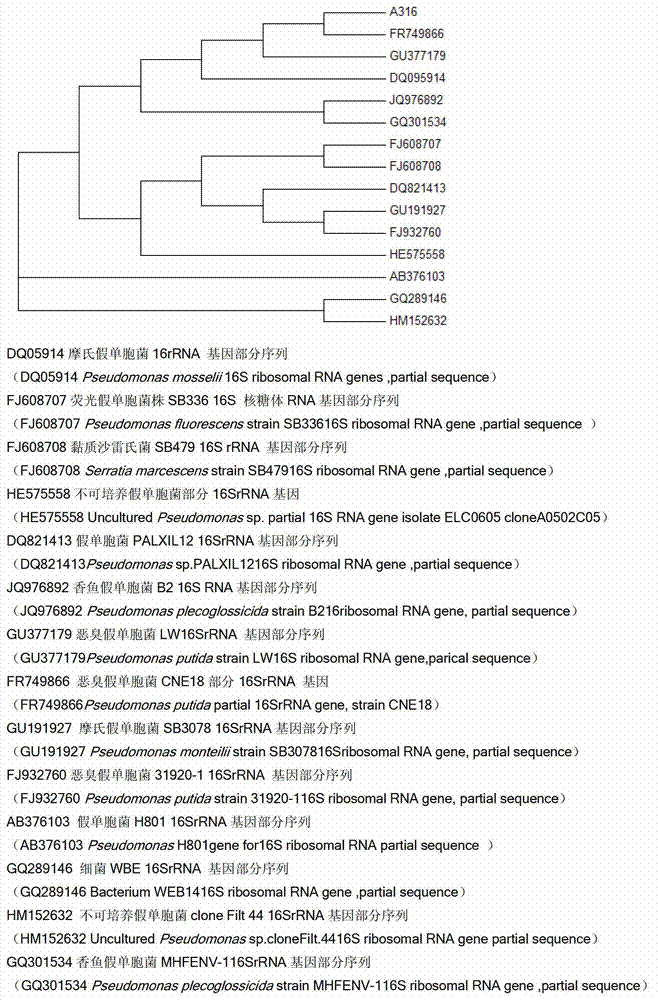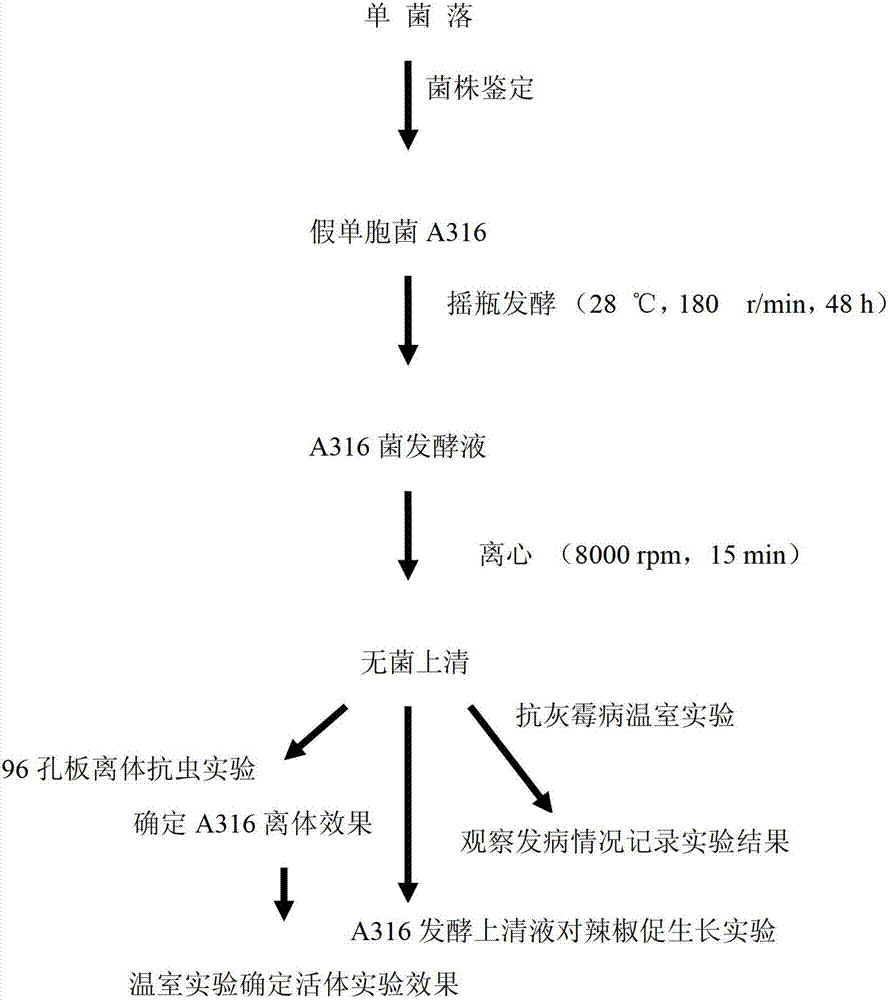Application of fermentation supernatant liquid of pseudomonas
A technology of fermentation supernatant and pseudomonas, applied in the field of agricultural microbiology, can solve the problems of reducing pesticide residues in vegetables, producing environment, adverse effects, etc. Good control effect and good biological control effect
- Summary
- Abstract
- Description
- Claims
- Application Information
AI Technical Summary
Problems solved by technology
Method used
Image
Examples
Embodiment 1
[0063] Example 1: Identification of Pseudomonas
[0064] Step 1: Routine identification and molecular-assisted identification of Pseudomonas
[0065] Inoculate Pseudomonas sp.MCCC NO.1A00316 on 2216E medium, culture at 28°C for 48 hours, observe and record the single colony morphology, and conduct gelatin hydrolysis test at the same time (reference: Zhao Bin et al., Microbiology Experiment (First Edition) . Beijing: Science Press, 2002 introduced the method). 16S rDNA identification, using upstream primer 27F5'AGAGTTTGATCCTGGCTCAG3' and downstream primer 1492R 5'GGTTACCTGTTAC GACTT3' to amplify 16S rDNA fragments (Suzuki K et al., Agromyces mediolanus sp.nov., nom.rev., comb.nov., a species for "Corynebacterium mediolanum" Mamoli 1939 and for some aniline-assimilating bacteria which contain 2,4-diaminobutyric acid in the cell wall peptidoglycan. Int J Syst Bacterio, 1996, 46:88-93). Use 20 μl reaction system: 1 μl upstream primer 27F, 1 μl downstream primer 1492R, 0.2 μl dNT...
Embodiment 2
[0069] Example 2: In Vitro Control Experiment of A316 Fermentation Supernatant to Meloidogyne incognita
[0070] Step 1: Fermentation of A316
[0071] 1) Streak, separate and activate the A316 strain on the plate to obtain a single colony;
[0072] 2) Pick a single colony and transfer it to a PA bottle for activation in a liquid shake flask;
[0073] 3) The seed liquid in the PA bottle was transferred to a 250ml Erlenmeyer flask and cultured in a shaker flask at 28°C for 48 hours until OD 600 =1.85;
[0074] 4) The fermentation broth after shaking the flask was centrifuged at 8000 rpm for 15 minutes to obtain the A316 fermentation supernatant for later use.
[0075] The second step: Toxicity determination of A316 to root-knot nematode incognita
[0076] 1) Use a 96-well plate for toxicity determination, and absorb 30 second-instar nematodes for each well;
[0077] 2) Add 160ul of fermentation supernatant and supplement to about 200ul with sterile water;
[0078] 3) Three...
Embodiment 3
[0086] Embodiment 3: Greenhouse experiment of A316 fermentation supernatant to root-knot nematode incognita
[0087] 1) Sterilize tomato seeds, disinfect with 70% (v / v) alcohol for 1 minute, sterilize with 2% (w / w) sodium hypochlorite for 10 minutes, and wash with sterile water three times;
[0088] 2) Tomato seeds germinate on filter paper filled with water;
[0089] 3) Plant the germinated seeds into 1000g of sterile culture soil (soil:sand=1:1), and inoculate one tomato in each pot;
[0090] 4) Inoculate after growing four cotyledons. When inoculating, insert 3 small holes evenly around the tomato seedlings with a glass rod, and mix the nematode suspension (300 head / well) and (or) fermentation supernatant (2ml / well) ) into small holes respectively, and then cover with sterilized soil. Do not water within 3 days after inoculation, and use a watering can to properly moisturize the leaf and soil surfaces to prevent nematodes from being washed away, and perform normal watering...
PUM
 Login to View More
Login to View More Abstract
Description
Claims
Application Information
 Login to View More
Login to View More - R&D
- Intellectual Property
- Life Sciences
- Materials
- Tech Scout
- Unparalleled Data Quality
- Higher Quality Content
- 60% Fewer Hallucinations
Browse by: Latest US Patents, China's latest patents, Technical Efficacy Thesaurus, Application Domain, Technology Topic, Popular Technical Reports.
© 2025 PatSnap. All rights reserved.Legal|Privacy policy|Modern Slavery Act Transparency Statement|Sitemap|About US| Contact US: help@patsnap.com



